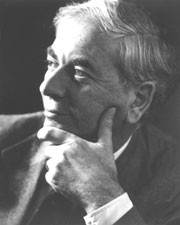
In the years after the Second World War, general relativity theory and cosmology were transformed. Previously seen as only of philosophical interest, they have become central strands in physics, and the new subject of relativistic astrophysics has come into being. Dennis Sciama, who died on 18 December last year, was one of the far-sighted physicists involved in this transition.
Sciama was a student of Paul Dirac, and like him became fascinated with Mach's principle — loosely, the idea that the nature of local physical laws is affected by the state of the whole Universe. Sciama developed a theory of gravity that incorporated this principle, his PhD thesis on the subject being widely quoted. Benefiting from many discussions with Hermann Bondi, Thomas Gold and Fred Hoyle, he developed the broad theme of how local physics relates to the Universe.
Sciama became a passionate believer in the Bondi–Gold–Hoyle steady-state theory (in which the Universe always expands at a constant rate), helping to develop observational tests of that theory. As he emphasized, the theory had the virtue of being disprovable. When it became untenable because of the radio-source and quasar number counts (there are more such sources at large distances than that theory allows), he reluctantly abandoned it. Sciama then became one of the pioneers investigating astrophysical interactions in the evolving and expanding Universe — in particular in studying the way radiation and matter have interacted and how the burgeoning fields of radio and X-ray astronomy could provide information on the thermal history of the Universe.
Here, the transforming event was the discovery in 1965 of the 3 K cosmic blackbody radiation — the relic radiation of the hot big bang — by Arno Penzias and Robert Wilson. This was then tied in to the theory of synthesis of light elements in the early Universe from protons and neutrons, and the theory of growth of large-scale structures (galaxies and clusters of galaxies) in the era after decoupling of matter and the background radiation. The resulting inhomogeneities caused anisotropies in the cosmic background radiation intensity measured today. With Martin Rees, Sciama helped develop the theory of these anisotropies. His considerable understanding of the interlocking set of astrophysical interactions in the early Universe was summarized in Modern Cosmology (Cambridge Univ. Press, 1971).
Sciama's career moves took in the universities of Cambridge, Oxford and Texas (Austin), and then the International School of Advanced Studies (SISSA) in Trieste, his interests becoming increasingly broad. They encompassed the structure of radio sources and quasars, X-ray astronomy, the physics of the interstellar and intergalactic medium, astroparticle physics, and the nature of the mysterious dark matter that pervades the Universe, as well as the thermodynamics of black holes and the nature of the vacuum in quantum theory. He also worked on gravitational theory. In particular, he investigated the inclusion of torsion in the theory (allowing for a kind of intrinsic spin in the geometry) and developed an intriguing integral formulation of the Einstein field equations.
More recently, Sciama worked hard on a scheme in which the dark matter in the Universe is taken to consist mainly of massive neutrinos which decay with a long half-life. These neutrinos produce photons, which could then be responsible for a range of observable astrophysical phenomena such as ionization of intergalactic gas. He formulated this theory so that it too was eventually falsifiable; it was a sadness for him when observations failed to support it.
The real impact of Sciama's career lay, however, not in his own contributions, impressive as they are, but in his creation of an enormously influential school of students. Sciama devoted his life to finding high-quality, dedicated students and helping them in their careers. He supervised over 70 PhD students, among them Stephen Hawking, Brandon Carter (formulator of the Anthropic Principle in cosmology), Sir Martin Rees, Philip Candelas, John Barrow and David Deutsch (originator of quantum computing). Students of students number well over 180, including such luminaries as Roger Blandford, Craig Hogan, Nick Kaiser and Peter Coles. A ‘family tree’ of this impressive group of relativists and astrophysicists is given in the Sciama Festschrift, The Renaissance of General Relativity and Cosmology, edited by myself and colleagues (Cambridge Univ. Press, 1993).
Sciama inculcated in his students the importance of physical and astrophysical understanding, the significance of rigorous mathematical analysis whenever this is possible, and the power of combining the two in a way leading to testable predictions. He encouraged them to be both adventurous and rigorous, and to make their thinking relevant to the physical problem at hand.
And as well as having his own students, he was a proponent of relativistic astrophysics and cosmology wherever he went. Indeed it was Sciama who interested Roger Penrose in gravitation theory when they were together at Cambridge, thereby opening the way to the systematic study of the causal properties of space–times and the famous Penrose–Hawking singularity theorems. These showed that (according to classical general relativity theory) there is indeed a beginning to the Universe, as well as an end to space–time when a massive object collapses to a black hole.
Sciama was a warm person with a love for the civilized things in life. He enjoyed good company, music, and opera, in the later part of his life often retreating to his flat in Venice where, with his wife Lydia, he enjoyed the Venetian lifestyle. When at work he always displayed an intellectual determination to get to grips with the issues concerned, bringing a formidable knowledge of physics and mathematics to bear in this endeavour. His forte was working on these problems with his students and colleagues. He was like a father to many of them, and will be missed both personally and as an inspirational figure in the field of study he loved so much.
Author information
Authors and Affiliations
Corresponding author
Rights and permissions
About this article
Cite this article
Ellis, G. Dennis Sciama (1926–99). Nature 403, 722 (2000). https://doi.org/10.1038/35001716
Issue Date:
DOI: https://doi.org/10.1038/35001716
